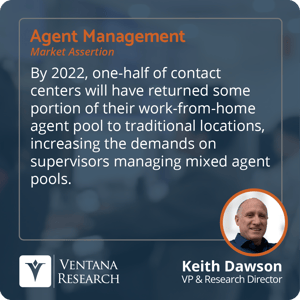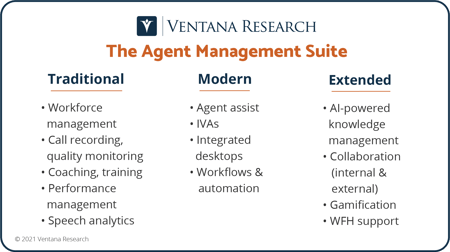The Pandemic Heightens Need for Agent Management
The primary effect of the pandemic on agent/workforce management beginning in 2020 was a rush to re-site and re-equip contact centers and agents. This was achieved with a surprising speed and smoothness industrywide. But once achieved on a “temporary” or “emergency” basis, it became clear that this shift was going to be semi-permanent. Even if the majority of the agent population moves back into standard centers, there is now a consensus that some portion of the workforce will work from home. As a result, the industry’s vendors have focused their messaging and short-term roadmaps on enhancing workforce engagement, or what we call agent management. These include promoting tools for measurement, management, and supervisory tools like mobile interfaces into workforce systems.
Along with the basic remote tools that agents need to do their core jobs, they need communication and collaboration tools to work together in groups and to be adequately supervised. The easiest way to add these functions has been to use existing unified communications (UC) tools, especially those that provide presence, messaging and video. And, not surprisingly, these UC tools are now widely cloud-based, which has thrown together UCaaS and CCaaS platforms into hybrid or parallel offerings that offer a one-stop shop for all communications services needed for internal and external work. All these trends have accelerated the steady move to the cloud for many types of contact center software, most especially the core multichannel interaction-routing functions.
One of the most profound realizations to come out of the pandemic era is that the way agents are managed and measured is out of date, no longer sufficient for the complexities of today’s contact center or the consumer environment that drives it. Traditional agent management (or workforce optimization, or agent performance optimization – they all mean the same thing) consists of a quartet of tools that have been refined since the 1990s and are functionally mature and commoditized: call recording, quality monitoring, workforce management and performance management. Definitionally these are a little elastic, but the core is easily recognizable: figure out how many full-time equivalents are needed to meet demand for a particular time period, and schedule them; capture audio of those calls and score them in agent evaluations; and measure the agent’s performance across different categories. So far, so good.
 But today’s agents are dispersed, taking them out from under the thumb of supervisors and out of range of serendipitous collaboration with peers. Their communication channels are more diverse. And the technology available to optimize their activities is more sophisticated.
But today’s agents are dispersed, taking them out from under the thumb of supervisors and out of range of serendipitous collaboration with peers. Their communication channels are more diverse. And the technology available to optimize their activities is more sophisticated.
Ventana Research asserts that by 2022, one-half of contact centers will have returned some portion of their work-from-home agent pool to traditional locations, increasing the demands on supervisors managing mixed agent pools.
That has accelerated a shift from traditional agent-management tools toward a more modern package that adds functionality to that original quartet: intelligent virtual assistants (IVAs); agent-assist or guidance driven by artificial intelligence (AI); and automation via workflows that streamlines processes and provides connections to back-office functions. Then, there are improved “agent management” applications that are further outside the standard definition but that affect agents and supervisors just the same: knowledge management, desktop integrations, gamification, and customer collaboration tools like co-browsing and bot-assisted chat.
These developments raise important questions for buyers and vendors: Who is an agent when the entire organization may be customer-facing? What skills must a modern agent possess and how are those identified in hiring and developed in training? Should centers expect to be spending more on training and on the tools themselves?
 There is talk in the industry about “WEM” – workforce engagement management. Judging by the description offered by several vendors, WEM is little more than traditional workforce optimization dressed up in a new package. It does not speak to the expansion of functionality as much as it tries to recast existing tools as being more proactive in fostering a happier (i.e., more productive) workforce. It also appears to be a pandemic-era response to the urgent need for upgraded tools for remote workers.
There is talk in the industry about “WEM” – workforce engagement management. Judging by the description offered by several vendors, WEM is little more than traditional workforce optimization dressed up in a new package. It does not speak to the expansion of functionality as much as it tries to recast existing tools as being more proactive in fostering a happier (i.e., more productive) workforce. It also appears to be a pandemic-era response to the urgent need for upgraded tools for remote workers.
A better way to think about workforce engagement in contact centers is through the framework of “agent management” - an expanded toolkit that includes the core functions of scheduling, quality and performance tracking, adding new components like workflow design and agent guidance tools that have emerged from recent innovations in AI and application development.
Managing agents in today’s more complex environment requires input from, and tools for, a broader group of people in multiple roles. At the most basic level, agents are tasked with more self-management in areas like scheduling, performance (through gamification) and even training. Managers, too, have a wider role, needing to maintain communications and visibility into agent activities and behavior while they work remotely.
And, as contact centers are more entwined with other parts of the organization, leadership requires insights into agent performance that are more detailed and relevant. Instead of metrics focused on activity (like handle time), they are increasingly looking for measures of value and outcome. This allows them to identify who can work with high-value customers, for example, or who is creative, collaborative, or has other qualities that can be used to improve customers’ experiences (and, therefore, business outcomes). As more, new, C-level executive positions like chief customer officers or experience officers become accountable for contact center performance, they will look to modern agent-management tools to give them a better picture of what the center actually accomplishes.
Several ideas flow from this. First, an expanded definition of agent management into new technology areas allows for a broader view of who is being managed. It aligns the skills needed in the contact center with those in the back office. That allows an organization to consider how it handles knowledge workers who touch customers or are involved in the customer-facing processes that surround the contact center.
Second, it opens the door to a reconsideration of the costs and benefits of spending on agents. Automation has the potential to change the fundamental calculations about labor costs, providing the option for centers to offer higher pay for specialty skills or particularly talented workers, and to spend more on training and coaching for the more complicated interactions that humans actually have to conduct.
The shifts we are seeing are evidence that the provision of agent-management systems is a strong differentiator for vendors that can (a) provide a broader set of tools and (b) articulate the use cases for extended agent management in terms of benefits. The trick here is to draw clear lines between the core tools used for basic contact center operations and the extended tools that have more nuanced value propositions lying outside the center itself. Organizations should evaluate the manageability and usability of their agent management applications, while ensuring the platform beneath them can support the adaptability and reliability required to operate in their organization.
Throughout the past year, the vendor response to both the urgency of the pandemic and the incremental evolutions of new technology have been somewhat ad hoc and opportunistic. Now would be the time to craft a more coherent strategy to ensure effective agent management. Primarily, that means educating the market on the new options and requirements of modern and extended agent management. Buyers should perform self-assessments to identify necessary new tools. Be aware that considering just “WEM” is insufficient; only examining routine scheduling or performance is not what is needed in a broader focus on agent management. That will ensure your short- to long-term success.
For further reading, see these Analyst Perspectives that discuss changes in the agent management process:
The Mandate for Contact Center and Agent Management
The 2021 Market Agenda for Customer Experience: Achieving Excellence in Engagement
Intelligent Virtual Agents Are an Imperative for Digital Self-Service
Regards,
Keith Dawson
Authors:

Keith Dawson
Director of Research, Customer Experience
Keith Dawson leads the software research and advisory in the Customer Experience (CX) expertise at Ventana Research, now part of ISG, covering applications that facilitate engagement to optimize customer-facing processes. His coverage areas include agent management, contact center, customer experience management, field service, intelligent self-service, voice of the customer and related software to support customer experiences.










